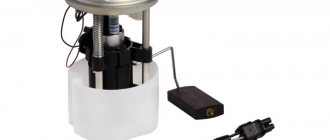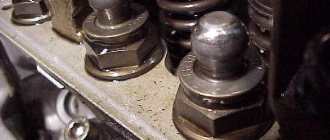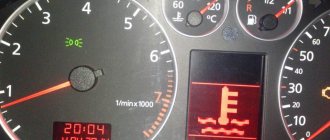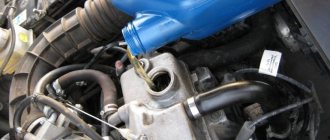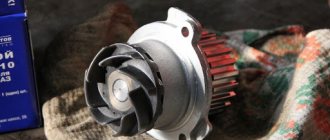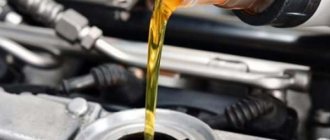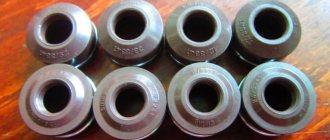The hydraulic compensator (HC) in the VAZ 2112 21124/21126 engine is the most important component of a car engine. Their use on the VAZ-2112 engine makes it possible not to periodically check thermal clearances, as on 8-valve VAZ engines. It eliminates the thermal gap between the valve lifter and the camshaft cam. Eliminating this gap allows you to ensure uninterrupted operation of the engine at the level of design parameters. During operation, if the operating conditions and instructions of the manufacturer are not observed, premature wear of this part occurs. At the same time, a characteristic knocking sound is heard in the engine. This sound tells us that the hydraulic compensator has failed and needs to be replaced. The reasons for failure of the hydraulic compensator may be the following:
• Contamination of the oil supply channels in the engine.
• Wear of the working surfaces of the check valve and plunger pair. • The occurrence of shock loads as a result of non-filling or partial filling of the hydraulic compensator with oil, in other words – its “airing”. Now let’s briefly go over each of the above points. The oil passages of the engine lubrication system must not be allowed to become contaminated. This is a clear violation of operational standards that can lead to serious consequences. The reasons for contamination of the oil passages may be:
• Using motor oil that does not comply with the instructions. • Untimely replacement of engine oil. • Malfunction of the oil filter.
As for increasing the seating gaps in the plunger pairs, in this case, increased oil leakage will occur from the high pressure chamber. In this case, the compensator will lose its resistance force and the effectiveness of the force of pressing the cam on the valve stem of the gas distribution mechanism will decrease. The internal space of the hydraulic compensator must be completely filled with oil. If this condition is not met, then the GC will not eliminate the gap in the parts of the gas distribution mechanism. As a result, dynamic loads will arise, in other words, shocks, which will lead to rapid wear of timing parts and a significant deterioration in engine performance. It should be remembered that malfunctions in the operation of the main engine can also be caused by the ingress of small particles into it with the oil, which appear as a result of wear of engine parts. In this case, the node may jam. If you do hear the aforementioned knock, then you should not immediately dramatize this event. The price for carrying out work to replace hydraulic compressors of a VAZ 2112 or Priora 16 valves in a car service center will fluctuate around 3,000 rubles, however, such work can be done with your own hands, you only need to strictly follow our detailed instructions below.
Replacing hydraulic compensators on a VAZ 2112
Using a 10mm wrench, unscrew the four nuts securing the plastic shield. After removing the oil filler cap, remove the plastic shield.
Using a 13mm wrench, loosen the nut securing the generator to the mounting plate.
By turning the adjusting bolt counterclockwise with a “10” wrench, we loosen the tension of the generator drive belt. We remove the belt.
Remove the receiver and engine intake manifold. We close the openings of the intake manifold with covers to prevent foreign objects from getting into it.
Remove the right wheel and the plastic shield of the engine compartment. Using the “19” head, turn the crankshaft clockwise by the pulley mounting bolt.
Rotate the lower pulley until the mark on the camshaft toothed pulley aligns with the installation tab on the rear timing cover.
Use a 17mm wrench to loosen the fastenings of the camshaft pulley. Remove the timing belt.
The marks on the timing belt guard must match the marks on the pulleys. Completely unscrew and remove the camshaft pulleys.
Using a 8mm socket, unscrew the 15 bolts securing the cylinder head cover.
Next, use the same “8” key to unscrew the 20 bolts securing the camshaft bearing housing.
Remove the camshaft bearing housing.
We take out the camshafts with oil seals.
Applying a magnet or magnetic screwdriver to the end of the hydraulic pusher, remove it from the cylinder head socket.
We take new hydraulic compensators and...
... install them in the nests.
Lubricate the bearing journals and camshaft cams with machine oil and place the shafts in the cylinder head supports. To distinguish the intake camshaft from the exhaust camshaft, a belt is made on the intake shaft near the first journal.
Tighten the nuts in the sequence shown in the photo until the bearings touch the cylinder head.
We install and tighten the valve cover, install the camshaft pulleys and timing belt. We assemble the remaining parts in reverse order.
A hydraulic compensator (HC) is a part of the engine block head, the purpose of which is to automatically adjust the thermal clearances of the engine valves in order to prevent the formation of gaps between the valves and the camshaft cams.
Causes and consequences of malfunction of VAZ 2112 hydraulic compensators
Failure to promptly change the oil and filter, or adding low-quality, contaminated or used engine oil to the engine lubrication system can lead to the following consequences:
- Increasing clearance in the plunger , which causes increased oil leakage from the bushing under the plunger. As a result, the hydraulic compensator does not have time to select gaps in the timing belt, and characteristic knocking noises appear.
- Wear or clogging of the ball valve , leading to an increase in oil leakage from the cavity under the plunger, resulting in loose closure, leading to wear of parts and their premature failure.
- Wedging of the plunger pair completely disables the hydraulic compensator. Loads occur in the timing belt, leading to wear and damage to the camshaft cams.
The other side... supports
The main reasons for failure of the hydraulic manifold (HC) are contamination of the engine oil channels and wear of the working surfaces of the check valve and a pair of pistons, which are made with a high degree of precision. Contamination is caused by using the wrong oil, not changing the oil on time, or a faulty oil filter allowing dirty oil to pass through the bypass valve.
As the seating clearance in a pair of pistons increases, oil losses from the high-pressure chamber increase. The hydraulic separator loses its “stiffness”, so the efficiency of transmitting cam force to the control valve stem decreases. The same thing happens when the check valve of the high-pressure chamber wears out. Malfunctions in the engine lubrication system slow down the filling of the main oil with oil and do not allow gaps in the distribution to be absorbed.
The internal volume of the HA must be filled with oil. An empty or partially filled (“air”) low loss header does not fulfill its main purpose: eliminating gaps in timing parts. As a result, shock loads arise, which manifest themselves as characteristic unevenness. This leads to accelerated wear of timing parts and deterioration of engine performance. Failures are also caused by particles of worn parts getting into the hydraulic fluid with oil - the unit may stall. Depending on where this happened, large gaps will appear in the timing belt or the valves will “stick” (the load on the camshaft increases, power decreases, etc.).
To prevent this from happening, you need to:
- check and maintain the internal cleanliness of the engine - replace the oil and oil filter within the time limits recommended by the car manufacturer, with a reduction factor of 0.6 - 0.9, taking into account the operating conditions of the car;
- Flush the engine before your next oil change using a slow "on-the-go" flush. If the internal surfaces of the engine are dirty (which is discovered, for example, when removing the timing belt), fast-acting detergents are not recommended, since dirt particles exfoliated along with the oil flow can get into the internal cavities of the drive compensators and disable them.
you need to know that small gaps between the moving elements of the hydraulic manifold determine the use of high-quality low-viscosity oils in the engine: synthetic or semi-synthetic (SAE 0W40, 5W40, 10W30, etc.). The use of mineral oils (eg SAE 15W40) is not recommended due to their high viscosity and tendency to form gum deposits.
Tips for replacing hydraulic lifters on a VAZ 2112
In some cases, valve clogging can be eliminated by flushing the hydraulic tappets. All other faults, as a rule, require replacement of hydraulic compensators.
The successful replacement of VAZ 2112 hydraulic compensators will be indicated by:
- improved timing gap adjustment;
- elimination of extraneous engine noise;
- implementation of smooth acceleration of the car (without failures at low speeds);
- reduction of engine vibration.
It is necessary to change the hydraulic pushers as a set; if this is not done, and only change the hydraulic valves that are knocking, there is no guarantee that after a while others will not start knocking and everything will have to be redone again.
To perform the work of replacing hydraulic compensators, the following tool is required:
- a set of keys;
- magnetic screwdriver;
- jack;
- degreaser and sealant for engine block;
- set of hydraulic compensators from VAZ-2112 (16 pcs.).
The price of VAZ 2112 hydraulic compensators from LADA with article number 21120100730000 will be about 200 rubles per piece. Total 3200 rubles per set.
The cost is indicated for spring 2022 in Moscow and the region.
The hydraulic pumps are knocking and the “OIL” light is on
Alternative.
My neighbor, who has owned a Niva-Chevrolet for more than 10 years, advised us to replace them completely with simple adjusting bolts from our domestic “classics”. He himself had already changed the hydraulic lifters 2 times until he was advised to do so in one of the services. Since then he hasn't had any problems.
Having gone to the service center, I consulted with specialists. They confirmed to me that on Niva they make such a replacement quite often and then do not return to them with problems.
It is not a problem to purchase adjusting bolts. In a store nearby they cost 800 rubles for 8 pieces. The problem was finding plates for them and springs for the rocker.
But this matter was resolved quite simply by disassembly, and cost 300 rubles for everything including bolts!
The service work, including adjusting the bolts and replacing the valve stem seals, cost me 1,000 rubles. Total issue price is 1300 rubles. + hour of time.
You can do it yourself, but the prospect of removing the camshaft and then installing it correctly, to be honest, did not appeal to me.
Replacing hydraulic compensators on VAZ-2110, 2111, 2112
Hydraulic compensators (hydraulic pushers) of valves are used to automatically adjust thermal valve clearances. In essence, they are a kind of gaskets between the camshaft cams and valves, capable of changing their thickness.
Their use in the engine makes it possible not to systematically adjust thermal clearances.
The design of the hydraulic compensator consists of a cylinder-shaped body and a plunger, including a bushing, a ball valve and a spring.
The principle of its operation is as follows. When the cam turns its blunt side towards the pusher, a gap appears between them. At this time, the spring-loaded plunger rises up, closing it, and the oil enters the plunger cavity through a channel with a ball valve.
Why are hydraulic “adjusters” needed?
As the engine gradually reaches operating temperature, its other components also heat up. The associated expansion of parts causes a decrease in a variety of gaps in the power unit. And adjusting the gaps in the gas distribution mechanism is a very important operation, since the stability of the engine largely depends on it. It is clear that manual adjustment is a tedious and ineffective task; special mechanisms cope with it much more successfully. Moreover, during active vehicle operation, the valves are constantly under both mechanical and thermal load. And we must not forget that all timing components heat up unevenly, which, combined with natural abrasion, leads to increased wear of the valve mechanism.
The operating principle of hydraulic valve compensators is based on ensuring optimal thermal clearance. But it should be different, since the intake valves, compared to the exhaust valves in contact with hot gases, heat up an order of magnitude less. In addition, “regulators” are able to take into account the wear of the valve mechanism, although this does not solve the problem of increased fuel consumption and a decrease in engine power.
Returning to the issue of manually adjusting the timing belt, one cannot help but notice that such an adjustment should be carried out after 15 thousand km. However, it is highly not recommended to carry out such a procedure without very specific skills, since it is necessary to take into account a wide variety of temperature fluctuations. This is the same as in the case of the average temperature in the ward, which does not provide objective data on the condition of the patients. And a completely different matter are hydraulic compensators that regulate the gap automatically, taking into account current parameters.
Malfunctions of hydraulic compensators
The main indicator of failure of hydraulic compensators is their characteristic knocking sound. It is he who signals that it is time for a replacement. There may be several reasons for this:
- spent resource;
- premature wear of the plunger pair due to wear products entering the device;
- clogged oil supply channels.
If the hydraulic pushers have become unusable after working for the required period, it means that the car owner paid maximum attention to the engine.
But the other two cases are a consequence of the use of low-quality, inappropriate oil, its untimely replacement, malfunctions of the oil pump or other elements of the lubrication system.
The hydraulic compensator will work ideally only when its internal space is completely filled with oil. Otherwise, dynamic loads will gradually destroy it and they begin to knock.
Do-it-yourself replacement of hydraulic compensators
The process of replacing hydraulic compensators itself is simple, but you will have to work hard to implement it, because it involves dismantling the valve cover and camshafts. The order of work is as follows.
1. Place the car on a flat surface and secure it with the parking brake.
2. Raise the hood of the car, disconnect the negative terminal.
3.Remove the engine protective cover.
4. Dismantle the receiver. We plug the inlet holes with a clean rag to prevent foreign objects and dirt from getting inside.
5. Dismantle the ignition module and crankcase ventilation hose.
6. Unscrew the bolt fixing the bracket for the injector power wires.
7. Unscrew the 15 bolts securing the cylinder head valve cover and dismantle it.
8.Having removed the cover, we check the condition of the hydraulic compensators by pressing on them from above with a screwdriver. A working hydraulic pusher should compress with great force. If significant effort is not required to compress it, the compensator is faulty.
9.Remove the drive gears from both camshafts.
10. Disconnect the oil pressure sensor connector.
11. Unscrew the 20 bolts securing the bearing housing.
12.Unscrew the nuts securing the rear shaft support bracket.
13. We dismantle it together with the bearing housing along with the spark plug guides.
14. We take out both camshafts (put them back according to the marks)
15.To remove hydraulic compensators from their sockets, use a magnet.
16. We remove the old hydraulic pushers. We install new ones in their place.
17. Installation is carried out in the reverse order, do not forget to set the camshaft marks.
18. We get rid of sealant residues at the joints with the cylinder head. We take into account the tension of the head mounting bolts.
19. Before assembly, apply special Loctite sealant to all head joints.
The result of the work
Having completed the installation work, we check the operation of the engine. Immediately after starting, the engine may work, making extraneous sounds in the form of clattering or tapping. They indicate that the hydraulic compensators need to be pumped, i.e. fill with oil, expelling the air.
To carry out this procedure, start the engine and run it for 5 minutes at 2500 rpm. After this, go to idle speed and wait 30 seconds. Next, turn off the engine and wait a minute.
Next time you start, listen again. If the sound does not disappear, repeat the procedure. Usually after 3-5 such pumpings the extraneous sounds disappear.
Tell me who changed the hydraulics, I bought a complete set of 16 pieces, they are 8 in a package, so you won’t sell some of the hard ones, but the other 8 soft ones are worth installing or not from INA
In general, hydraulic compensators should be rigid and definitely should not be pressed down by hand without effort, unfortunately I don’t know how soft they are; if they are pressed too easily, they will knock.
Why tighten the cylinder head bolts? As I understand it, the cylinder head does not need to be completely removed.
I have a knocking noise, I also filled it with oil and it keeps knocking, can I fix it somehow?
How much do hydraulic compensators cost?
Tell me when you start the hydraulics when they are cold, they knock, everything seems to heat up normally, then again a quiet knock turns up the speed, everything is quiet. What could this be?
They started knocking after I filled it with Shell Helix, before that I drove Mobil-1 and had no problems. Now the campaign will have to change.
What malfunctions most often occur with hydraulic compensators?
If you drove earlier VAZ models, then you remember the unpleasant knocking sound that signaled a problem in the engine valve system. In model 2112, the engine uses the same extraneous noise to notify the owner about a malfunction of the hydraulic compensators. Typically, their failure occurs for the following reasons:
- development of their resource;
- engine wear products getting inside the pushers;
- untimely oil change, which led to clogging of its supply channels.
If replacement of hydraulic pushers was necessary at the end of their service life, then this is direct evidence that the car owner pays sufficient attention to engine care. First of all, VAZ-2112 owners need to:
- observe oil change intervals;
- do not fill the engine with low-quality lubricating fluid;
- monitor the serviceability of oil systems;
- Check the oil level regularly.
For ideal operation, the hydraulic tappet must be completely immersed in oil. This will reduce the dynamic load on this engine element and prevent its failure. An insufficient amount of lubricant leads to the fact that the hydraulic pushers are gradually destroyed and their replacement becomes necessary.
What it is
Hydraulic compensators are parts for tuning a car engine. The device automatically adjusts the valve clearance.
The GKK was never installed by the factory on the old sevens. Some cars of that time had mechanical type regulators. But the efficiency of their work left much to be desired.
Owners of the VAZ 2107 must manually adjust the valve clearance every ten thousand kilometers. To do this, you have to dismantle the cover and use a feeler gauge to set the gaps.
Built-in mechanical elements are subject to wear. An incorrectly adjusted gap leads to increased engine noise. As a result, the car's dynamics decrease and fuel consumption increases. After 50 thousand mileage it is necessary to install new valves.
Hydraulic compensators on the VAZ 2107 are free of these disadvantages. The part lasts a long time: it works properly for up to 150 thousand kilometers. The gap is set automatically and is constantly maintained at the desired level.
The engine responds positively to such care, which is reflected in an increase in engine life, its power and in a decrease in gasoline consumption.
Approximate price of hydraulic compensators
Unlike foreign-made cars, parts for the VAZ-2112 are affordable. In most auto parts stores for domestic cars you can find a set of hydraulic compensators for a sixteen-valve engine at a low price - about two thousand rubles. Before purchasing, carefully examine each pusher to avoid purchasing a defective part.
Among manufacturers of spare parts for VAZ-2112 engines, the INA brand occupies a leading position, but it is very often counterfeited. In order to make the right choice, watch a video in advance about the features of branded hydraulic pushers. Pay close attention to how much a set of pushers costs, since a high-quality spare part cannot be cheap.
How to replace hydraulic pushers
Replacing the pushers is not always necessary to eliminate knocking in the engine; in some cases, you can do without it by following a few simple steps:
- remove the gas distribution part cover;
- turn the crankshaft (you need to open the valve that is knocking);
- move the contact points using a special spring;
- put the cover back in place;
- test run the engine.
Remember that any work must be carried out after stopping the engine for half an hour. If the problem of valve knocking on the VAZ-2112 is not solved by the procedure described above, then it is best to replace them.
It is best not to change the hydraulic pushers individually, but to immediately buy a set of 16 valves and carry out a comprehensive repair. Even a beginner can carry out the replacement using the following instructions:
- Remove the plastic cover.
- Close the intake manifold caps and remove the receiver.
- Remove the ignition module.
- Using a 10-mm open-end wrench, loosen the injector conductors and disconnect them.
- Take the 8 socket and remove the 15 bolts from the valve cover. Remove it and dismantle the cylinder heads.
- Use a metal rod to check how efficient the pushers are. To do this, you just need to click on each compensator. This test can only be carried out when the camshaft knuckle is turned to the hydraulic compensator with its blunt side. A damaged pusher is pressed very easily, without effort.
- Once you have confirmed that the pushers are faulty, you can begin further work on replacing them. To do this, remove the toothed pulleys from the camshaft.
- Disconnecting the oil pressure sensor.
- Using a 8mm socket, unscrew the housing that hides the camshaft bearings. It should have 20 bolts.
- A rod is attached to the rear engine mount bracket. You need to remove the bolt that secures this connection, and then dismantle the bracket itself
- Next, remove the camshaft housing, these mechanisms themselves, seals and spark plug tubes.
- Remove the plugs from the camshaft housing and cylinder head. Now you can use a magnet to remove the compensators and replace them with new ones. Assembly is carried out in reverse order. Before doing this, it is necessary to clean the cylinder head and bearing housing from old grease, and also lubricate the journals and camshafts of both camshafts with clean engine oil.
It is best to watch the video instructions before starting work. With its help, it will be much easier for you to replace the pushers. Only visual instructions will help you properly repair the valve system.
Diagnosis of GCC
Listening to knocks and monitoring the dynamics of the VAZ 2107 engine is, of course, a useful habit. But you still have to roll up your sleeves and drive the car into the garage. After all, for an accurate diagnosis, you need to get the device and inspect it personally.
- Remove the valve cover.
- Using a special wrench, rotate the crankshaft so that the cylinder piston is in the compression stroke.
- Try pressing the rocker arm on the intake valve.
If the rocker arm easily gives in to your efforts, the hydraulic compensator requires replacement.
You can also check the functionality of the hydraulic supports using a screwdriver. If you press on a faulty mechanism, it will give play.
